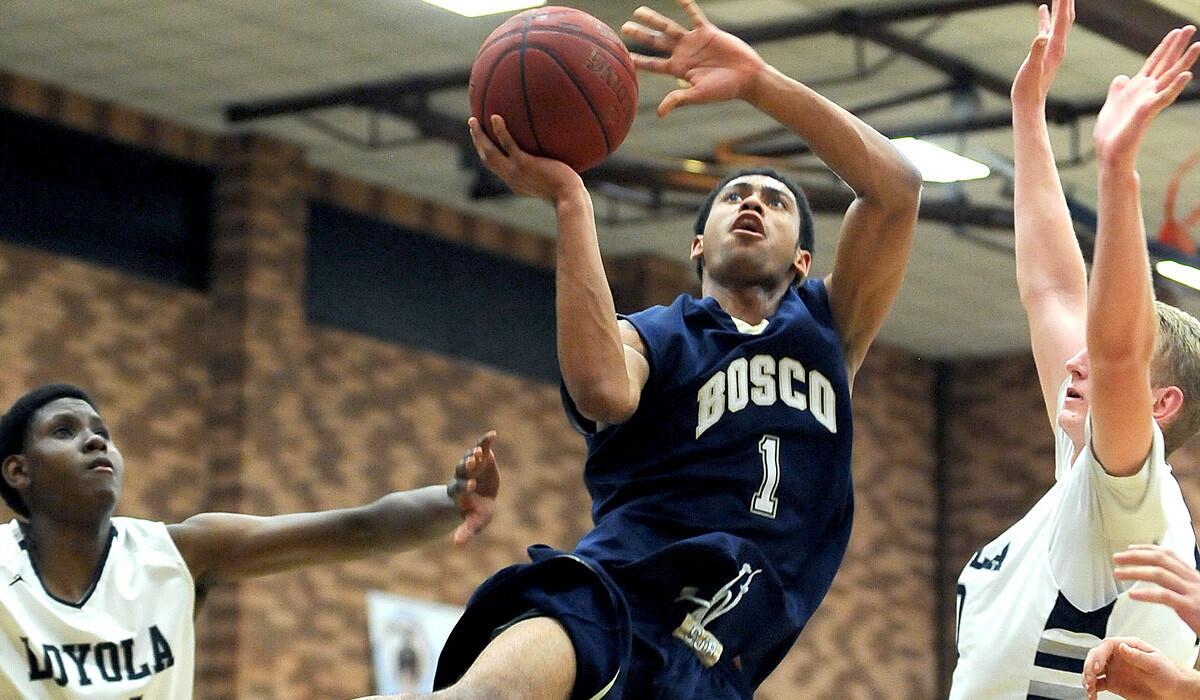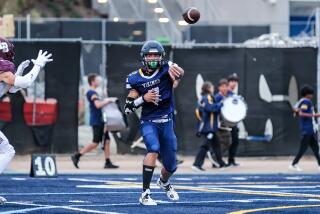High school transfers turn neighborhood teams into outdated notion

- Share via
It took something extra to transform the basketball team at St. John Bosco High into a winner.
The Braves needed more talent than could be found in their working-class community of Bellflower. They needed a versatile guard, an athletic forward and a big scorer.
The athletes transferred to the small Catholic school from campuses in Glassell Park, the Crenshaw district and Pasadena, forming a de facto all-star squad that captured a state title in the spring.
“Long gone are the days of the neighborhood team,” their coach, Derrick Taylor, said. “You don’t seek transfers, but to win at the highest level, you need a transfer or two.”
More than a dozen Southern California high school champions last year benefited from outsiders in the starting lineup.
Coaches and administrators say a nomadic culture has taken hold across the region. The summer months have become transfer season, with young athletes hopping from one place to the next, often determining which schools prevail at football, basketball and baseball during the next school year.
A shift in state rules in 2012 made it easier for players to bounce around. Athletes who transfer once without changing residence no longer have to sit out a year, as they often did before. They can begin playing after about a month.
“The rule opened up the door,” said Alan Trejo, a pitcher who jumped from Cathedral High to Warren High in Downey last fall
About 2,000 students made use of this reduced penalty during its first year. That number rose to more than 3,500 in 2013-14.
“I’ve been coaching for 21 years and have never seen the movement we’ve had the last couple of years,” said Jaime Ortiz, the football coach at San Clemente High. “It reminds me of free agency, and I don’t know if that’s the best thing for high school sports.”
About 15,000 California athletes transfer each school year, according to data reviewed by The Times.
California Interscholastic Federation statistics do not reflect why students make a switch. Often families move or parents want a better academic setting for their children, but some athletes acknowledge that they switch schools for better athletic opportunities.
They want more playing time or a greater chance of winning. They want the exposure that can lead to a college scholarship.
Newly arrived quarterbacks led Westlake Village Westlake and Oak Park to league titles during the past school year. Both had left nearby Oaks Christian because they grew impatient of waiting for the older starter to graduate.
Outsiders helped Mater Dei to a championship season in basketball and did the same for Bishop Amat in baseball.
At Chaminade High in West Hills, the basketball team had two capable big men but needed a backcourt star. Point guard Michael Oguine, unhappy at a nearby public school, arrived just in time to guide the Eagles to a state title.
“Whether people like it or not, this is the way athletics are going,” said Todd Wolfson, the Chaminade coach. “There’s nothing you can do unless somebody makes a change.”
CIF officials say they were compelled to loosen the rules when the state Legislature recommended that families have as many choices as possible in selecting a school. The federation also worried about rising legal costs as more parents challenged the old restrictions.
For the most part, players who move into the attendance area of their new school become eligible to play immediately. Those who switch without moving can participate in practices but must sit out the first month or so of games.
Coaches are not allowed to recruit players from elsewhere and officials say they try to ensure that no undue influence — recruiting — prompted the transfer, but that doesn’t allay suspicions and hard feelings.
Some opponents do not like the fact that Mission Viejo’s football program had 16 transfers on its varsity team last season. Some of them — such as quarterback Ian Fieber, whose family moved — played significant roles.
“The running joke is, you’re not playing Mission Viejo, you’re playing a South Orange County all-star team,” said a rival coach who spoke anonymously for fear of being rebuked by his administration.
Football players are most likely to transfer, according to state records. Basketball players rank second.
Regardless of the sport, transfers have become so frequent that it can be hard to keep track of teams from season to season.
Trejo was part of an exodus that saw eight young players lead Cathedral — a small school near downtown Los Angeles — to a league baseball title in 2012, then leave after their coach took another job.
At one point last spring, it seemed as if two Orange County schools had conducted a basketball trade, with junior guard Rex Pflueger jumping from JSerra to Mater Dei and 7-foot sophomore Jayce Johnson moving the opposite direction.
And St. John Bosco, for all its success, has watched basketball players come and go through a revolving door of talent. This summer, standout guard Tyler Dorsey left for Pasadena Maranatha.
Roger Blake, the CIF’s executive director, looks at the overall numbers and says: “The culture has absolutely changed in the last five years. It has become a very me-me society for a small number of people.”
At Crespi High, where the starting quarterback last fall was a transfer, administrators now say they want to buck the trend. The Encino school will no longer use financial aid to entice players, a common practice among private schools. The football coach insists that no one will be admitted solely on the basis of athletic prowess.
“The truth is, Crespi wasn’t following its mission statement and we’re getting back to that,” said Troy Thomas, entering the second year of his second stint on the job. “We develop the Crespi man, and part of that is football, part of that is baseball, part of that is theater. You don’t come here only for football.”
At Loyola High in Los Angeles, which rarely accepts transfers, volleyball Coach Mike Boehle raises another concern.
“I feel bad for the kids who have spent three years in a program, waiting to get their shot playing varsity,” he said. “Somebody is making decisions to bring in athletes and they’re brushed aside.
“Where’s the loyalty?”
If top athletes continue to move freely, some leagues could become competitively unbalanced as successful programs draw all the best talent, leaving have-nots in their wake.
CIF officials have begun to ponder the creation of a super division for transfer-laden teams. “Our job is to try to create equal competition,” Blake said.
In the meantime, coaches are likely to accept any star player that comes their way. As St. John Bosco Principal Casey Yeazel said: “There’s a new normal.”
A few months before Dorsey, Daniel Hamilton and Vance Jackson led the St. John Bosco basketball team to a state title, the football team defeated Concord De La Salle in the state’s most prestigious bowl game to complete a 16-0 season.
The Braves’ contingent of 20 football transfers included six players who became eligible in October after sitting out about a month of the season. They joined a trio, including top college prospect Jaleel Wadood, who came from Lakewood High the year before.
Coach Jason Negro didn’t hesitate to accept the newcomers onto his roster. He views the movement of high school athletes in terms of supply and demand.
“It is a parent’s prerogative where they want to put their child,” he said. “If we are offering the type of program they are looking for, that’s important for us to welcome kids with open arms.”
[email protected]; Twitter: LATSondheimer
[email protected]; Twitter: @LATimesWharton
More to Read
Get our high school sports newsletter
Prep Rally is devoted to the SoCal high school sports experience, bringing you scores, stories and a behind-the-scenes look at what makes prep sports so popular.
You may occasionally receive promotional content from the Los Angeles Times.








